Novel Steroidal[17,16-d]pyrimidines Derived from Epiandrosterone and Androsterone: Synthesis, Characterization and Configuration-Activity Relationships
Abstract
1. Introduction
2. Results and Discussion
2.1. Chemistry
2.2. Pharmacology Evaluation
2.2.1. Inhibitory Effects of the Target Compounds
2.2.2. Selectivity Profiling of Compound 3a
2.2.3. Structure and Activity Relationships (SARs) and Molecular Docking
3. Conclusions
4. Experimental
4.1. Instrumentation and Chemicals
4.2. Chemical Synthesis
4.2.1. General Synthetic Procedure for Intermediates 2a–l and 5a–l
16-Benzylidene-3-hydroxy-10,13-dimethyltetradecahydro-1H-cyclopenta[a]phenanthren-17(2H)-one 2a
16-(2-Chlorobenzylidene)-3-hydroxy-10,13-dimethyltetradecahydro-1H-cyclopenta[a]phenanthren-17(2H)-one 2b
16-(4-Chlorobenzylidene)-3-hydroxy-10,13-dimethyltetradecahydro-1H-cyclopenta[a]phenanthren-17(2H)-one 2c
16-(2-Fluorobenzylidene)-3-hydroxy-10,13-dimethyltetradecahydro-1H-cyclopenta[a]phenanthren-17(2H)-one 2d
16-(4-Fluorobenzylidene)-3-hydroxy-10,13-dimethyltetradecahydro-1H-cyclopenta[a]phenanthren-17(2H)-one 2e
16-(2-Trifluorobenzylidene)-3-hydroxy-10,13-dimethyltetradecahydro-1H-cyclopenta[a]phenanthren-17(2H)-one 2f
16-(4-Trifluorobenzylidene)-3-hydroxy-10,13-dimethyltetradecahydro-1H-cyclopenta[a]phenanthren-17(2H)-one 2g
16-(2,4-Dichlorobenzylidene)-3-hydroxy-10,13-dimethyltetradecahydro-1H-cyclopenta[a]phenanthren-17(2H)-one 2h
16-(2-Fluoro-4-bromobenzylidene)-3-hydroxy-10,13-dimethyltetradecahydro-1H-cyclopenta[a]phenanthren-17(2H)-one 2i
16-(4-Methoxybenzylidene)-3-hydroxy-10,13-dimethyltetradecahydro-1H-cyclopenta[a]phenanthren-17(2H)-one 2j
16-(3,4,5-Trimethoxybenzylidene)-3-hydroxy-10,13-dimethyltetradecahydro-1H-cyclopenta[a]phenanthren-17(2H)-one 2k
16-(3-Pyridinmethylene)-3-hydroxy-10,13-dimethyltetradecahydro-1H-cyclopenta[a]phenanthren-17(2H)-one 2l
16-Benzylidene-3-hydroxy-10,13-dimethyltetradecahydro-1H-cyclopenta[a]phenanthren-17(2H)-one 5a
16-(2-Chlorobenzylidene)-3-hydroxy-10,13-dimethyltetradecahydro-1H-cyclopenta[a]phenanthren-17(2H)-one 5b
16-(4-Chlorobenzylidene)-3-hydroxy-10,13-dimethyltetradecahydro-1H-cyclopenta[a]phenanthren-17(2H)-one 5c
16-(2-Fluorobenzylidene)-3-hydroxy-10,13-dimethyltetradecahydro-1H-cyclopenta[a]phenanthren-17(2H)-one 5d
16-(4-Fluorobenzylidene)-3-hydroxy-10,13-dimethyltetradecahydro-1H-cyclopenta[a]phenanthren-17(2H)-one 5e
16-(2-Trifluorobenzylidene)-3-hydroxy-10,13-dimethyltetradecahydro-1H-cyclopenta[a]phenanthren-17(2H)-one 5f
16-(4-Trifluorobenzylidene)-3-hydroxy-10,13-dimethyltetradecahydro-1H-cyclopenta[a]phenanthren-17(2H)-one 5g
16-(2,4-Dichlorobenzylidene)-3-hydroxy-10,13-dimethyltetradecahydro-1H-cyclopenta[a]phenanthren-17(2H)-one 5h
16-(2-Fluoro-4-bromobenzylidene)-3-hydroxy-10,13-dimethyltetradecahydro-1H-cyclopenta[a]phenanthren-17(2H)-one 5i
16-(4-Methoxybenzylidene)-3-hydroxy-10,13-dimethyltetradecahydro-1H-cyclopenta[a]phenanthren-17(2H)-one 5j
16-(3,4,5-Trimethoxybenzylidene)-3-hydroxy-10,13-dimethyltetradecahydro-1H-cyclopenta[a]phenanthren-17(2H)-one 5k
16-(3-Pyridinmethylene)-3-hydroxy-10,13-dimethyltetradecahydro-1H-cyclopenta[a]phenanthren-17(2H)-one 5l
4.2.2. General Synthetic Procedure for Target Compounds 3a–l and 6a–l
10-Amino-6a,8a-dimethyl-12-phenyl-tetradecahydro-1H-naphtho[2′,1′:4,5]indeno[1,2-d]pyrimidin-4-ol 3a
10-Amino-12-(2-chlorophenyl)-6a,8a-dimethyl-tetradecahydro-1H-naphtho[2′,1′:4,5]indeno[1,2-d]pyrimidin-4-ol 3b
10-Amino-12-(4-chlorophenyl)-6a,8a-dimethyl-tetradecahydro-1H-naphtho[2′,1′:4,5]indeno[1,2-d]pyrimidin-4-ol 3c
10-Amino-12-(2-fluorophenyl)-6a,8a-dimethyl-tetradecahydro-1H-naphtho[2′,1′:4,5]indeno[1,2-d]pyrimidin-4-ol 3d
10-Amino-12-(4-fluorophenyl)-6a,8a-dimethyl-tetradecahydro-1H-naphtho[2′,1′:4,5]indeno[1,2-d]pyrimidin-4-ol 3e
10-Amino-12-(2-trifluoromethylphenyl)-6a,8a-dimethyl-tetradecahydro-1H-naphtho[2′,1′:4,5]indeno[1,2-d]pyrimidin-4-ol 3f
10-Amino-12-(4-trifluoromethylphenyl)-6a,8a-dimethyl-tetradecahydro-1H-naphtho[2′,1′:4,5]indeno[1,2-d]pyrimidin-4-ol 3g
10-Amino-12-(2,4-dichlorophenyl)-6a,8a-dimethyl-tetradecahydro-1H-naphtho[2′,1′:4,5]indeno[1,2-d]pyrimidin-4-ol 3h
10-Amino-12-(2-fluoro-4-bromophenyl)-6a,8a-dimethyl-tetradecahydro-1H-naphtho[2′,1′:4,5]indeno[1,2-d]pyrimidin-4-ol 3i
10-Amino-12-(4-methoxyphenyl)-6a,8a-dimethyl-tetradecahydro-1H-naphtho[2′,1′:4,5]indeno[1,2-d]pyrimidin-4-ol 3j
10-Amino-12-(3,4,5-trimethoxyphenyl)-6a,8a-dimethyl-tetradecahydro-1H-naphtho[2′,1′:4,5]indeno[1,2-d]pyrimidin-4-ol 3k
10-Amino-12-(3-pyridinyl)-6a,8a-dimethyl-tetradecahydro-1H-naphtho[2′,1′:4,5]indeno[1,2-d]pyrimidin-4-ol 3l
10-Amino-6a,8a-dimethyl-12-phenyl-tetradecahydro-1H-naphtho[2′,1′:4,5]indeno[1,2-d]pyrimidin-4-ol 6a
10-Amino-12-(2-chlorophenyl)-6a,8a-dimethyl-tetradecahydro-1H-naphtho[2′,1′:4,5]indeno[1,2-d]pyrimidin-4-ol 6b
10-Amino-12-(4-chlorophenyl)-6a,8a-dimethyl-tetradecahydro-1H-naphtho[2′,1′:4,5]indeno1,2-d]pyrimidin-4-ol 6c
10-Amino-12-(2-fluorophenyl)-6a,8a-dimethyl-tetradecahydro-1H-naphtho[2′,1′:4,5]indeno[1,2-d]pyrimidin-4-ol 6d
10-Amino-12-(4-fluorophenyl)-6a,8a-dimethyl-tetradecahydro-1H-naphtho[2′,1′:4,5]indeno[1,2-d]pyrimidin-4-ol 6e
10-Amino-12-(2-trifluoromethylphenyl)-6a,8a-dimethyl-tetradecahydro-1H-naphtho[2′,1′:4,5]indeno[1,2-d]pyrimidin-4-ol 6f
10-Amino-12-(4-trifluoromethylphenyl)-6a,8a-dimethyl-tetradecahydro-1H-naphtho[2′,1′:4,5]indeno[1,2-d]pyrimidin-4-ol 6g
10-Amino-12-(2,4-dichlorophenyl)-6a,8a-dimethyl-tetradecahydro-1H-naphtho[2′,1′:4,5]indeno[1,2-d]pyrimidin-4-ol 6h
10-Amino-12-(2-fluoro-4-bromophenyl)-6a,8a-dimethyl-tetradecahydro-1H-naphtho[2′,1′:4,5]indeno[1,2-d]pyrimidin-4-ol 6i
10-Amino-12-(4-methoxyphenyl)-6a,8a-dimethyl-tetradecahydro-1H-naphtho[2′,1′:4,5]indeno[1,2-d]pyrimidin-4-ol 6j
10-Amino-12-(3,4,5-trimethoxyphenyl)-6a,8a-dimethyl-tetradecahydro-1H-naphtho[2′,1′:4,5]indeno[1,2-d]pyrimidin-4-ol 6k
10-Amino-12-(3-pyridinyl)-6a,8a-dimethyl-tetradecahydro-1H-naphtho[2′,1′:4,5]indeno[1,2-d]pyrimidin-4-ol 6l
4.3. In Vitro Cytotoxicity Assay
4.4. Kinase Activity Assay
4.5. Molecular Docking Study
Supplementary Materials
Author Contributions
Funding
Institutional Review Board Statement
Informed Consent Statement
Data Availability Statement
Conflicts of Interest
Sample Availability
References
- Mazumder, K.; Aktar, A.; Roy, P.; Biswas, B.; Hossain, M.; Sarkar, K.; Bachar, S.; Ahmed, F.; Monjur-Al-Hossain, A.; Fukase, K. A Review on Mechanistic Insight of Plant Derived Anticancer Bioactive Phytocompounds and Their Structure Activity Relationship. Molecules 2022, 27, 3036. [Google Scholar] [CrossRef] [PubMed]
- Ayati, A.; Moghimi, S.; Toolabi, M.; Foroumadi, A. Pyrimidine-based EGFR TK inhibitors in targeted cancer therapy. Eur. J. Med. Chem. 2021, 221, 113523. [Google Scholar] [CrossRef] [PubMed]
- Nadar, S.; Khan, A. Pyrimidine: An elite heterocyclic leitmotif in drug discovery-synthesis and biological activity. Chem. Biol. Drug Des. 2021, 100, 818–842. [Google Scholar] [CrossRef] [PubMed]
- Zhuang, J.; Ma, S. Recent Development of Pyrimidine-Containing Antimicrobial Agents. ChemMedChem 2020, 15, 1875–1886. [Google Scholar] [CrossRef] [PubMed]
- Song, X.J.; Shao, Y.; Dong, X.G. Microwave-assisted synthesis of some novel fluorinated pyrazolo [3, 4-d] pyrimidine derivatives containing 1, 3, 4-thiadiazole as potential antitumor agents. Chin. Chem. Lett. 2011, 22, 1036–1038. [Google Scholar] [CrossRef]
- Kurumurthy, C.; Rao, P.S.; Rao, P.S.; Narsaiah, B.; Velatooru, L.; Pamanji, R.; Rao, J.V. Synthesis of novel alkyltriazole tagged pyrido [2, 3-d] pyrimidine derivatives and their anticancer activity. Eur. J. Med. Chem. 2011, 46, 3462–3468. [Google Scholar] [CrossRef]
- Liu, Z.; Wang, Y.; Lin, H.; Zuo, D.; Wang, L.; Zhao, Y.; Gong, P. Design, synthesis and biological evaluation of novel thieno [3, 2-d] pyrimidine derivatives containing diaryl urea moiety as potent antitumor agents. Eur. J. Med. Chem. 2014, 85, 215–227. [Google Scholar] [CrossRef]
- Zhu, W.F.; Zhai, X.; Li, S.; Cao, Y.Y.; Gong, P.; Liu, Y.J. Synthesis and cytotoxic activity of novel 2, 6-disubstituted-4-mor-pholinothieno [3, 2-d] pyrimidines as potent anti-tumor agents. Chin. Chem. Lett. 2012, 23, 703–706. [Google Scholar] [CrossRef]
- Al-Issa, S. Synthesis and anticancer activity of some fused pyrimidines and related heterocycles. Saudi Pharm. J. 2013, 21, 305–316. [Google Scholar] [CrossRef]
- Kumar, R.N.; Dev, G.J.; Ravikumar, N.; Swaroop, D.K.; Debanjan, B.; Bharath, G.; Narsaiah, B.; Jain, S.N.; Rao, A.G. Synthesis of novel triazole/isoxazole functionalized 7-(trifluoromethyl) pyrido [2, 3-d] pyrimidine derivatives as promising anticancer and antibacterial agents. Bioorg. Med. Chem. Lett. 2016, 26, 2927–2930. [Google Scholar] [CrossRef]
- Lv, N.; Sun, M.; Liu, C.; Li, J. Design and synthesis of 2-phenylpyrimidine coumarin derivatives as anticancer agents. Bioorg. Med. Chem. Lett. 2017, 27, 4578–4581. [Google Scholar] [CrossRef] [PubMed]
- Meneghesso, S.; Vanderlinden, E.; Stevaert, A.; McGuigan, C.; Balzarini, J.; Naesens, L. Synthesis and biological evaluation of pyrimidine nucleoside monophosphate prodrugs targeted against influenza virus. Antivir. Res. 2012, 94, 35–43. [Google Scholar] [CrossRef] [PubMed]
- Xu, X.; Wang, J.; Yao, Q. Synthesis and quantitative structure–activity relationship (QSAR) analysis of some novel oxadiazolo [3, 4-d] pyrimidine nucleosides derivatives as antiviral agents. Bioorg. Med. Chem. Lett. 2015, 25, 241–244. [Google Scholar] [CrossRef]
- Amblard, F.; Aucagne, V.; Guenot, P.; Schinazi, R.F.; Agrofoglio, L.A. Synthesis and antiviral activity of novel acyclic nucleosides in the 5-alkynyl-and 6-alkylfuro [2, 3-d] pyrimidine series. Bioorg. Med. Chem. 2005, 13, 1239–1248. [Google Scholar] [CrossRef] [PubMed]
- Sari, O.; Roy, V.; Métifiot, M.; Marchand, C.; Pommier, Y.; Bourg, S.; Bonnet, P.; Schinazi, R.F.; Agrofoglio, L.A. Synthesis of dihydropyrimidine α, γ-diketobutanoic acid derivatives targeting HIV integrase. Eur. J. Med. Chem. 2015, 104, 127–138. [Google Scholar] [CrossRef]
- El-Gaby, M.; Gaber, A.; Atalla, A.; Abd Al-Wahab, K. Novel synthesis and antifungal activity of pyrrole and pyrrolo [2, 3-d] pyrimidine derivatives containing sulfonamido moieties. Il Farm. 2002, 57, 613–617. [Google Scholar] [CrossRef]
- Chen, Q.; Zhu, X.-L.; Jiang, L.-L.; Liu, Z.-M.; Yang, G.-F. Synthesis, antifungal activity and CoMFA analysis of novel 1, 2, 4-triazolo [1, 5-a] pyrimidine derivatives. Eur. J. Med. Chem. 2008, 43, 595–603. [Google Scholar] [CrossRef]
- Maddila, S.; Gorle, S.; Seshadri, N.; Lavanya, P.; Jonnalagadda, S.B. Synthesis, antibacterial and antifungal activity of novel benzothiazole pyrimidine derivatives. Arab. J. Chem. 2016, 9, 681–687. [Google Scholar] [CrossRef]
- Bhalgat, C.M.; Ali, M.I.; Ramesh, B.; Ramu, G. Novel pyrimidine and its triazole fused derivatives: Synthesis and investigation of antioxidant and anti-inflammatory activity. Arab. J. Chem. 2014, 7, 986–993. [Google Scholar] [CrossRef]
- Quiroga, J.; Romo, P.E.; Ortiz, A.; Isaza, J.H.; Insuasty, B.; Abonia, R.; Nogueras, M.; Cobo, J. Synthesis, structures, electrochemical studies and antioxidant activity of 5-aryl-4-oxo-3, 4, 5, 8-tetrahydropyrido [2, 3-d] pyrimidine-7-carboxylic acids. J. Mol. Struct. 2016, 1120, 294–301. [Google Scholar] [CrossRef]
- Malik, N.; Dhiman, P.; Verma, P.K.; Khatkar, A. Design, synthesis, and biological evaluation of thiourea and guanidine derivatives of pyrimidine-6-carboxylate. Res. Chem. Intermed. 2015, 41, 7981–7993. [Google Scholar] [CrossRef]
- Kotaiah, Y.; Nagaraju, K.; Harikrishna, N.; Rao, C.V.; Yamini, L.; Vijjulatha, M. Synthesis, docking and evaluation of antioxidant and antimicrobial activities of novel 1, 2, 4-triazolo [3, 4-b][1, 3, 4] thiadiazol-6-yl) selenopheno [2, 3-d] pyrimidines. Eur. J. Med. Chem. 2014, 75, 195–202. [Google Scholar] [CrossRef]
- Vartale, S.P.; Halikar, N.K.; Pawar, Y.D.; Tawde, K.V. Synthesis and evaluation of 3-cyano-4-imino-2-methylthio-4H-pyrido[1,2-a]pyrimidine derivatives as potent antioxidant agents. Arab. J. Chem. 2016, 9, S1117–S1124. [Google Scholar] [CrossRef]
- Marepu, N.; Yeturu, S.; Pal, M. 1,2,3-Triazole fused with pyridine/pyrimidine as new template for antimicrobial agents: Regioselective synthesis and identification of potent N-heteroarenes. Bioorg. Med. Chem. Lett. 2018, 28, 3302–3306. [Google Scholar] [CrossRef]
- AlNeyadi, S.S.; Salem, A.A.; Ghattas, M.A.; Atatreh, N.; Abdou, I.M. Antibacterial activity and mechanism of action of the benzazole acrylonitrile-based compounds: In vitro, spectroscopic, and docking studies. Eur. J. Med. Chem. 2017, 136, 270–282. [Google Scholar] [CrossRef] [PubMed]
- He, H.; Xia, H.; Xia, Q.; Ren, Y.; He, H. Design and optimization of N-acylhydrazone pyrimidine derivatives as E. coli PDHc E1 inhibitors: Structure-activity relationship analysis, biological evaluation and molecular docking study. Bioorg. Med. Chem. 2017, 25, 5652–5661. [Google Scholar] [CrossRef] [PubMed]
- Pathak, A.K.; Pathak, V.; Seitz, L.E.; Suling, W.J.; Reynolds, R.C. Antimycobacterial agents. 1. Thio analogues of purine. J. Med. Chem. 2004, 47, 273–276. [Google Scholar] [CrossRef] [PubMed]
- Johar, M.; Manning, T.; Tse, C.; Desroches, N.; Agrawal, B.; Kunimoto, D.Y.; Kumar, R. Growth Inhibition of Mycobacterium bovis, Mycobacterium tuberculosis and Mycobacterium avium In Vitro: Effect of 1-β-d-2 ‘-Arabinofuranosyl and 1-(2 ′-Deoxy-2 ′-fluoro-β-d-2 ′-ribofuranosyl) Pyrimidine Nucleoside Analogs. J. Med. Chem. 2007, 50, 3696–3705. [Google Scholar] [CrossRef]
- Ashour, H.M.; Shaaban, O.G.; Rizk, O.H.; El-Ashmawy, I.M. Synthesis and biological evaluation of thieno [2′, 3′: 4, 5] pyrimido [1, 2-b][1, 2, 4] triazines and thieno [2, 3-d][1, 2, 4] triazolo [1, 5-a] pyrimidines as anti-inflammatory and analgesic agents. Eur. J. Med. Chem. 2013, 62, 341–351. [Google Scholar] [CrossRef]
- Sahu, M.; Siddiqui, N.; Sharma, V.; Wakode, S. 5, 6-Dihydropyrimidine-1 (2H)-carbothioamides: Synthesis, in vitro GABA-AT screening, anticonvulsant activity and molecular modelling study. Bioorg. Chem. 2018, 77, 56–67. [Google Scholar] [CrossRef]
- Huang, L.; Ding, J.; Li, M.; Hou, Z.; Geng, Y.; Li, X.; Yu, H. Discovery of [1, 2, 4]-triazolo [1, 5-a] pyrimidine-7 (4H)-one derivatives as positive modulators of GABAA1 receptor with potent anticonvulsant activity and low toxicity. Eur. J. Med. Chem. 2020, 185, 111824. [Google Scholar] [CrossRef] [PubMed]
- Severina, H.I.; Skupa, O.O.; Voloshchuk, N.I.; Suleiman, M.M.; Georgiyants, V.A. Synthesis and anticonvulsant activity of 6-methyl-2-((2-oxo-2-arylethyl) thio) pyrimidin-4 (3 H)-one derivatives and products of their cyclization. Pharmacia 2019, 66, 141–146. [Google Scholar] [CrossRef]
- Sahu, M.; Siddiqui, N.; Iqbal, R.; Sharma, V.; Wakode, S. Design, synthesis and evaluation of newer 5, 6-dihydropyrimidine-2 (1H)-thiones as GABA-AT inhibitors for anticonvulsant potential. Bioorg. Chem. 2017, 74, 166–178. [Google Scholar] [CrossRef]
- Sahin, Z.; Ertas, M.; Berk, B.; Biltekin, S.N.; Yurttas, L.; Demirayak, S. Studies on non-steroidal inhibitors of aromatase enzyme; 4-(aryl/heteroaryl)-2-(pyrimidin-2-yl) thiazole derivatives. Bioorg. Med. Chem. Res. 2018, 26, 1986–1995. [Google Scholar] [CrossRef] [PubMed]
- Tripathi, M.; Khan, S.I.; Thakur, A.; Ponnan, P.; Rawat, D.S. 4-Aminoquinoline-pyrimidine-aminoalkanols: Synthesis, in vitro antimalarial activity, docking studies and ADME predictions. New J. Chem. 2015, 39, 3474–3483. [Google Scholar] [CrossRef]
- Agarwal, A.; Srivastava, K.; Puri, S.; Chauhan, P.M. Synthesis of 2, 4, 6-trisubstituted pyrimidines as antimalarial agents. Bioorg. Med. Chem. 2005, 13, 4645–4650. [Google Scholar] [CrossRef]
- Kumar, D.; Khan, S.I.; Tekwani, B.L.; Ponnan, P.; Rawat, D.S. Synthesis, antimalarial activity, heme binding and docking studies of 4-aminoquinoline–pyrimidine based molecular hybrids. RSC Adv. 2014, 4, 63655–63669. [Google Scholar] [CrossRef]
- Pretorius, S.I.; Breytenbach, W.J.; De Kock, C.; Smith, P.J.; N’Da, D.D. Synthesis, characterization and antimalarial activity of quinoline–pyrimidine hybrids. Bioorg. Med. Chem. 2013, 21, 269–277. [Google Scholar]
- Azeredo, L.F.S.; Coutinho, J.P.; Jabor, V.A.; Feliciano, P.R.; Nonato, M.C.; Kaiser, C.R.; Menezes, C.M.S.; Hammes, A.S.; Caffarena, E.R.; Hoelz, L.V. Evaluation of 7-arylaminopyrazolo [1, 5-a] pyrimidines as anti-Plasmodium falciparum, antimalarial, and Pf-dihydroorotate dehydrogenase inhibitors. Eur. J. Med. Chem. 2017, 126, 72–83. [Google Scholar] [CrossRef]
- Yadav, R.R.; Khan, S.I.; Singh, S.; Khan, I.A.; Vishwakarma, R.A.; Bharate, S.B. Synthesis, antimalarial and antitubercular activities of meridianin derivatives. Eur. J. Med. Chem. 2015, 98, 160–169. [Google Scholar] [CrossRef]
- Rani, J.; Kumar, S.; Saini, M.; Mundlia, J.; Verma, P.K. Biological potential of pyrimidine derivatives in a new era. Res. Chem. Intermed. 2016, 42, 6777–6804. [Google Scholar] [CrossRef]
- Bukhari, S.; Butt, A.; Amjad, M.; Ahmad, W.; Shah, V.; Trivedi, A. Synthesis and evaluation of chalcone analogues based pyrimidines as angiotensin converting enzyme inhibitors. Pak. J. Biol. Sci. 2013, 16, 1368–1372. [Google Scholar] [CrossRef] [PubMed]
- Marvaniya, H.M.; Parikh, P.K.; Sen, D.J. Synthesis and in-vitro screening of 3, 4-dihydropyrimidin-2 (1H)-one derivatives for antihypertensive and calcium channel blocking activity. J. Appl. Pharm. Sci. 2011, 01, 109–113. [Google Scholar]
- Alam, O.; Khan, S.A.; Siddiqui, N.; Ahsan, W.; Verma, S.P.; Gilani, S.J. Antihypertensive activity of newer 1, 4-dihydro-5-pyrimidine carboxamides: Synthesis and pharmacological evaluation. Eur. J. Med. Chem. 2010, 45, 5113–5119. [Google Scholar] [CrossRef]
- Katouah, H.A.; Gaffer, H.E. Synthesis and docking study of pyrimidine derivatives scaffold for anti-hypertension application. ChemistrySelect 2019, 4, 6250–6255. [Google Scholar] [CrossRef]
- Tozkoparan, B.; Ertan, M.; Kelicen, P.; Demirdamar, R. Synthesis and anti-inflammatory activities of some thiazolo [3, 2-a] pyrimidine derivatives. Il Farm. 1999, 54, 588–593. [Google Scholar] [CrossRef] [PubMed]
- Yejella, R.P.; Atla, S.R. A study of anti-inflammatory and analgesic activity of new 2, 4, 6-trisubstituted pyrimidines. Chem. Pharm. Bull. 2011, 59, 1079–1082. [Google Scholar] [CrossRef] [PubMed]
- Zhou, J.P.; Ding, Y.W.; Zhang, H.B.; Xu, L.; Dai, Y. Synthesis and anti-inflammatory activity of imidazo [1, 2-a] pyrimidine derivatives. Chin. Chem. Lett. 2008, 19, 669–672. [Google Scholar] [CrossRef]
- Keche, A.P.; Hatnapure, G.D.; Tale, R.H.; Rodge, A.H.; Birajdar, S.S.; Kamble, V.M. A novel pyrimidine derivatives with aryl urea, thiourea and sulfonamide moieties: Synthesis, anti-inflammatory and antimicrobial evaluation. Bioorg. Med. Chem. Lett. 2012, 22, 3445–3448. [Google Scholar] [CrossRef]
- Mohamed, M.S.; Kamel, R.; Fatahala, S.S. Synthesis and biological evaluation of some thio containing pyrrolo [2, 3-d] pyrimidine derivatives for their anti-inflammatory and anti-microbial activities. Eur. J. Med. Chem. 2010, 45, 2994–3004. [Google Scholar] [CrossRef]
- Sondhi, S.M.; Jain, S.; Dinodia, M.; Shukla, R.; Raghubir, R. One pot synthesis of pyrimidine and bispyrimidine derivatives and their evaluation for anti-inflammatory and analgesic activities. Bioorg. Med. Chem. 2007, 15, 3334–3344. [Google Scholar] [CrossRef] [PubMed]
- Pang, X.; Liu, X.; Liu, Y.; Liu, W.; Li, Y.; Yu, G.; Tian, X.; Zhang, Y.; Song, J.; Jin, C.; et al. Drug Discovery Targeting Focal Adhesion Kinase (FAK) as a Promising Cancer Therapy. Molecules 2021, 26, 4250. [Google Scholar] [CrossRef] [PubMed]
- Rashid, H.; Martines, M.; Duarte, A.; Jorge, J.; Rasool, S.; Muhammad, R.; Ahmad, N.; Umar, M. Research developments in the syntheses, anti-inflammatory activities and structure-activity relationships of pyrimidines. RSC Adv. 2021, 11, 6060–6098. [Google Scholar] [CrossRef] [PubMed]
- Kumar, S.; Narasimhan, B. Therapeutic potential of heterocyclic pyrimidine scaffolds. Chem. Cent. J. 2018, 12, 38. [Google Scholar] [CrossRef] [PubMed]
- Iikubo, K.; Kondoh, Y.; Shimada, I.; Matsuya, T.; Mori, K.; Ueno, Y.; Okada, M. Discovery of N-{2-Methoxy-4-[4-(4-methylpiperazin-1-yl)piperidin-1-yl]phenyl}-N′-[2-(propane-2-sulfonyl)phenyl]-1,3,5-triazine-2,4-diamine (ASP3026), a Potent and Selective Anaplastic Lymphoma Kinase (ALK) Inhibitor. Chem. Pharm. Bull. 2018, 66, 251–262. [Google Scholar] [CrossRef] [PubMed]
- Vagiannis, D.; Novotna, E.; Skarka, A.; Kammerer, S.; Küpper, J.; Chen, S.; Guo, L.; Staud, F.; Hofman, J. Ensartinib (X-396) Effectively Modulates Pharmacokinetic Resistance Mediated by ABCB1 and ABCG2 Drug Efflux Transporters and CYP3A4 Biotransformation Enzyme. Cancers 2020, 12, 813. [Google Scholar] [CrossRef]
- Huang, Y.-Y.; Wang, L.-Y.; Chang, C.-H.; Kuo, Y.-H.; Kaneko, K.; Takayama, H.; Kimura, M.; Juang, S.-H.; Wong, F.F. One-pot synthesis and antiproliferative evaluation of pyrazolo [3, 4-d] pyrimidine derivatives. Tetrahedron 2012, 68, 9658–9664. [Google Scholar] [CrossRef]
- Ibrahim, D.A.; Ismail, N.S. Design, synthesis and biological study of novel pyrido [2, 3-d] pyrimidine as anti-proliferative CDK2 inhibitors. Eur. J. Med. Chem. 2011, 46, 5825–5832. [Google Scholar] [CrossRef]
- Jiang, Q.; Li, M.; Li, H.; Chen, L. Entrectinib, a new multi-target inhibitor for cancer therapy. Biomed. Pharmacother. Biomed. Pharmacother. 2022, 150, 112974. [Google Scholar] [CrossRef]
- Tutka, P.; Mróz, K.; Mróz, T.; Buszewicz, G.; Aebisher, D.; Bartusik-Aebisher, D.; Kołodziejczyk, P.; Łuszczki, J.J. Effects of androsterone on the protective action of various antiepileptic drugs against maximal electroshock-induced seizures in mice. Psychoneuroendocrinology 2019, 101, 27–34. [Google Scholar] [CrossRef]
- El Kihel, L. Oxidative metabolism of dehydroepiandrosterone (DHEA) and biologically active oxygenated metabolites of DHEA and epiandrosterone (EpiA)--recent reports. Steroids 2012, 77, 10–26. [Google Scholar] [CrossRef] [PubMed]
- Yoshida, S.; Honda, A.; Matsuzaki, Y.; Fukushima, S.; Tanaka, N.; Takagiwa, A.; Fujimoto, Y.; Miyazaki, H.; Salen, G. Anti-proliferative action of endogenous dehydroepiandrosterone metabolites on human cancer cell lines. Steroids 2003, 68, 73–83. [Google Scholar] [CrossRef] [PubMed]
- Ke, S.; Wei, Y.; Shi, L.; Yang, Q.; Yang, Z. Synthesis of novel steroid derivatives derived from dehydroepiandrosterone as potential anticancer agents. Anti-Cancer Agents Med. Chem. 2013, 13, 1291–1298. [Google Scholar] [CrossRef] [PubMed]
- Ke, S.; Shi, L.; Zhang, Z.; Yang, Z. Steroidal[17,16-d]pyrimidines derived from dehydroepiandrosterone: A convenient synthesis, antiproliferation activity, structure-activity relationships, and role of heterocyclic moiety. Sci. Rep. 2017, 7, 44439. [Google Scholar] [CrossRef]
- Ke, S.; Shi, L.; Yang, Z. Discovery of novel isatin-dehydroepiandrosterone conjugates as potential anticancer agents. Bioorg. Med. Chem. Lett. 2015, 25, 4628–4631. [Google Scholar] [CrossRef]
- Ke, S.; Li, N.; Ke, T.; Shi, L.; Zhang, Z.; Fang, W.; Zhang, Y.; Wang, K.; Zhou, R.; Wan, Z.; et al. Synthesis and evaluation of steroidal thiazoline conjugates as potential antiviral agents. Future Med. Chem. 2018, 10, 2589–2605. [Google Scholar] [CrossRef]
- Ke, S.; Zhang, Z.; Liu, M.; Fang, W.; Huang, D.; Wan, Z.; Zhou, R.; Wang, K.; Shi, L. Synthesis and bioevaluation of novel steroidal isatin conjugates derived from epiandrosterone/androsterone. J. Enzym. Inhib. Med. Chem. 2019, 34, 1607–1614. [Google Scholar] [CrossRef]
- Tchédam Ngatcha, B.; Luu-The, V.; Labrie, F.; Poirier, D. Androsterone 3α-Ether-3β-Substituted and Androsterone 3β-Substituted Derivatives as Inhibitors of Type 3 17β-Hydroxysteroid Dehydrogenase: Chemical Synthesis and Structure-Activity Relationship. J. Med. Chem. 2005, 48, 5257–5268. [Google Scholar] [CrossRef]
- Malikova, J.; Swaczynova, J.; Kolar, Z.; Strnad, M. Anticancer and antiproliferative activity of natural brassinosteroids. Phytochemistry 2008, 69, 418–426. [Google Scholar] [CrossRef]
- Steigerová, J.; Rárová, L.; Oklešt’ková, J.; Křížová, K.; Levková, M.; Šváchová, M.; Kolář, Z.; Strnad, M. Mechanisms of natural brassinosteroid-induced apoptosis of prostate cancer cells. Food Chem. Toxicol. 2012, 50, 4068–4076. [Google Scholar] [CrossRef]
- Elmegeed, G.A.; Khalil, W.K.B.; Mohareb, R.M.; Ahmed, H.H.; Abd-Elhalim, M.M.; Elsayed, G.H. Cytotoxicity and gene expression profiles of novel synthesized steroid derivatives as chemotherapeutic anti-breast cancer agents. Bioorg. Med. Chem. 2011, 19, 6860–6872. [Google Scholar] [CrossRef] [PubMed]
- Rarova, L.; Zahler, S.; Liebl, J.; Krystof, V.; Sedlak, D.; Bartunek, P.; Kohout, L.; Strnad, M. Brassinosteroids inhibit in vitro angiogenesis in human endothelial cells. Steroids 2012, 77, 1502–1509. [Google Scholar] [CrossRef] [PubMed]
- Cui, J.; Liu, L.; Zhao, D.; Gan, C.; Huang, X.; Xiao, Q.; Qi, B.; Yang, L.; Huang, Y. Synthesis, characterization and antitumor activities of some steroidal derivatives with side chain of 17-hydrazone aromatic heterocycle. Steroids 2015, 95, 32–38. [Google Scholar] [CrossRef] [PubMed]
- Jensen, M.; Schmidt, S.; Fedosova, N.U.; Mollenhauer, J.; Jensen, H.H. Synthesis and evaluation of cardiac glycoside mimics as potential anticancer drugs. Bioorg. Med. Chem. 2011, 19, 2407–2417. [Google Scholar] [CrossRef] [PubMed]
- He, X.; Tang, J.; Qiao, A.; Wang, G.; Jiang, M.; Liu, R.H.; Yao, X. Cytotoxic biotransformed products from cinobufagin by Mucor spinosus and Aspergillus Niger. Steroids 2006, 71, 392–402. [Google Scholar] [CrossRef] [PubMed]
- Alley, M.; Scudiero, D.; Monks, A.; Hursey, M.; Czerwinski, M.; Fine, D.; Abbott, B.; Mayo, J.; Shoemaker, R.; Boyd, M. Feasibility of drug screening with panels of human tumor cell lines using a microculture tetrazolium assay. Cancer Res. 1988, 48, 589–601. [Google Scholar]
- Brown, N.R.; Korolchuk, S.; Martin, M.P.; Stanley, W.A.; Moukhametzianov, R.; Noble, M.E.; Endicott, J.A. CDK1 structures reveal conserved and unique features of the essential cell cycle CDK. Nat. Commun. 2015, 6, 6769. [Google Scholar] [CrossRef]
- Ke, S.; Shi, L.; Cao, X.; Yang, Q.; Liang, Y.; Yang, Z. Heterocycle-functional gramine analogues: Solvent- and catalyst-free synthesis and their inhibition activities against cell proliferation. Eur. J. Med. Chem. 2012, 54, 248–254. [Google Scholar] [CrossRef]
- Morris, G.M.; Huey, R.; Lindstrom, W.; Sanner, M.F.; Belew, R.K.; Goodsell, D.S.; Olson, A.J. AutoDock4 and AutoDockTools4: Automated docking with selective receptor flexibility. J. Comput. Chem. 2009, 30, 2785–2791. [Google Scholar] [CrossRef]
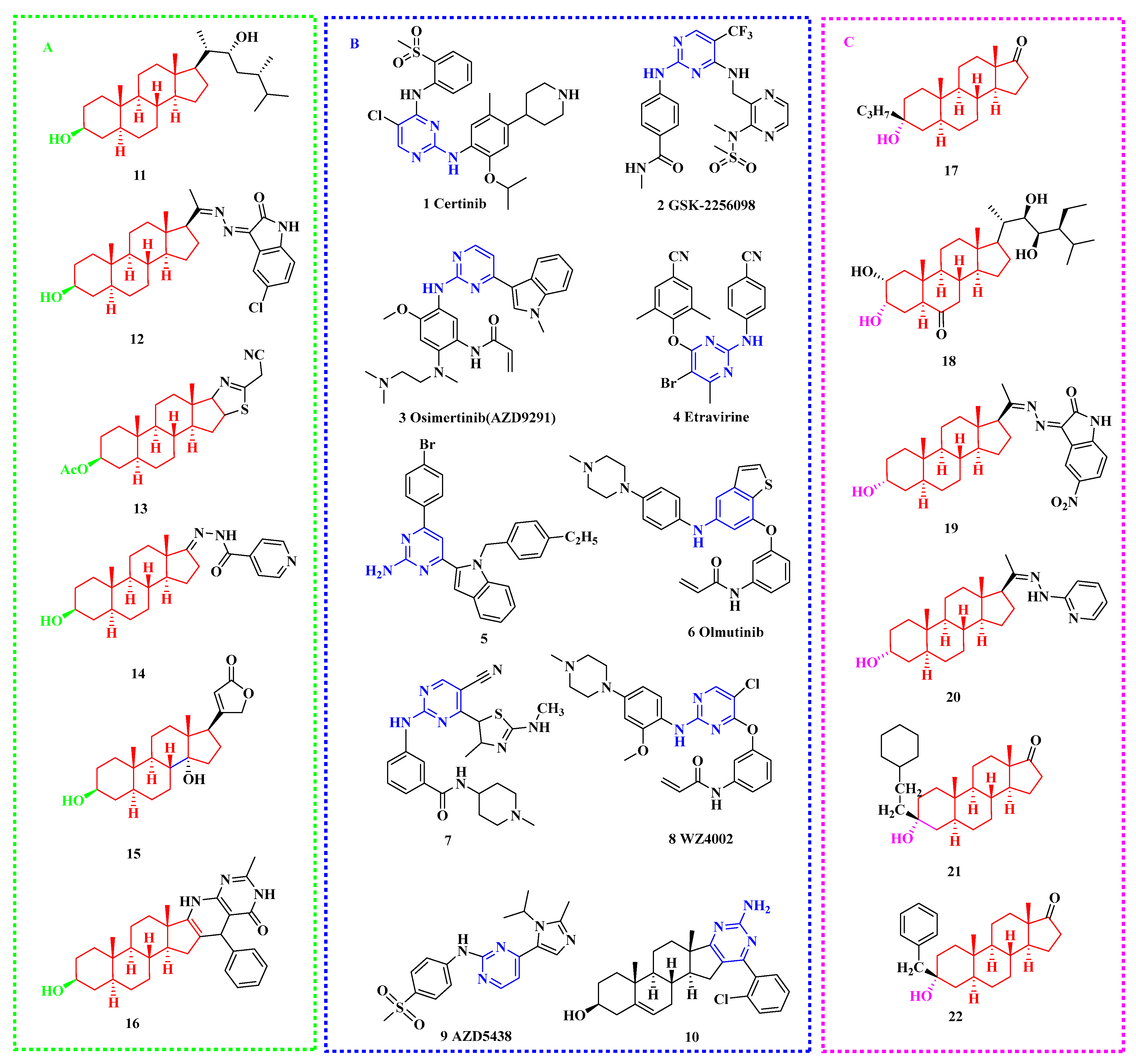

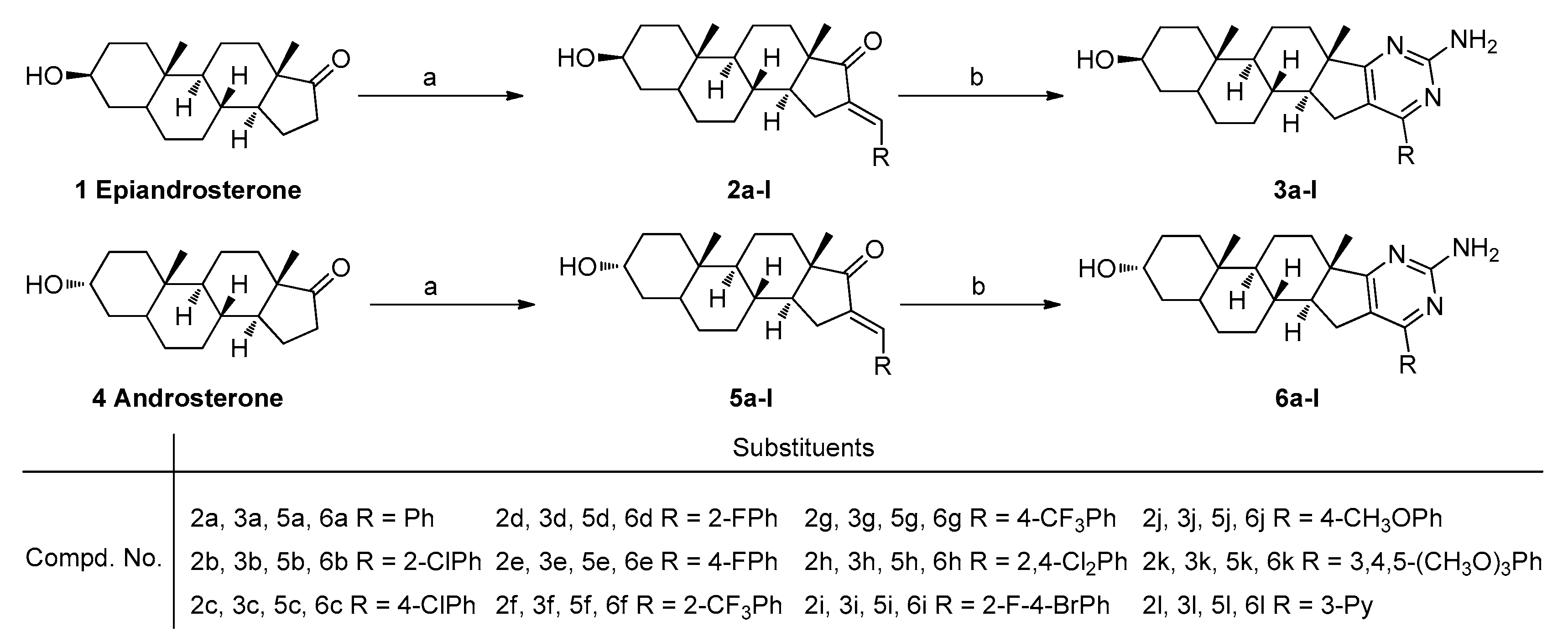
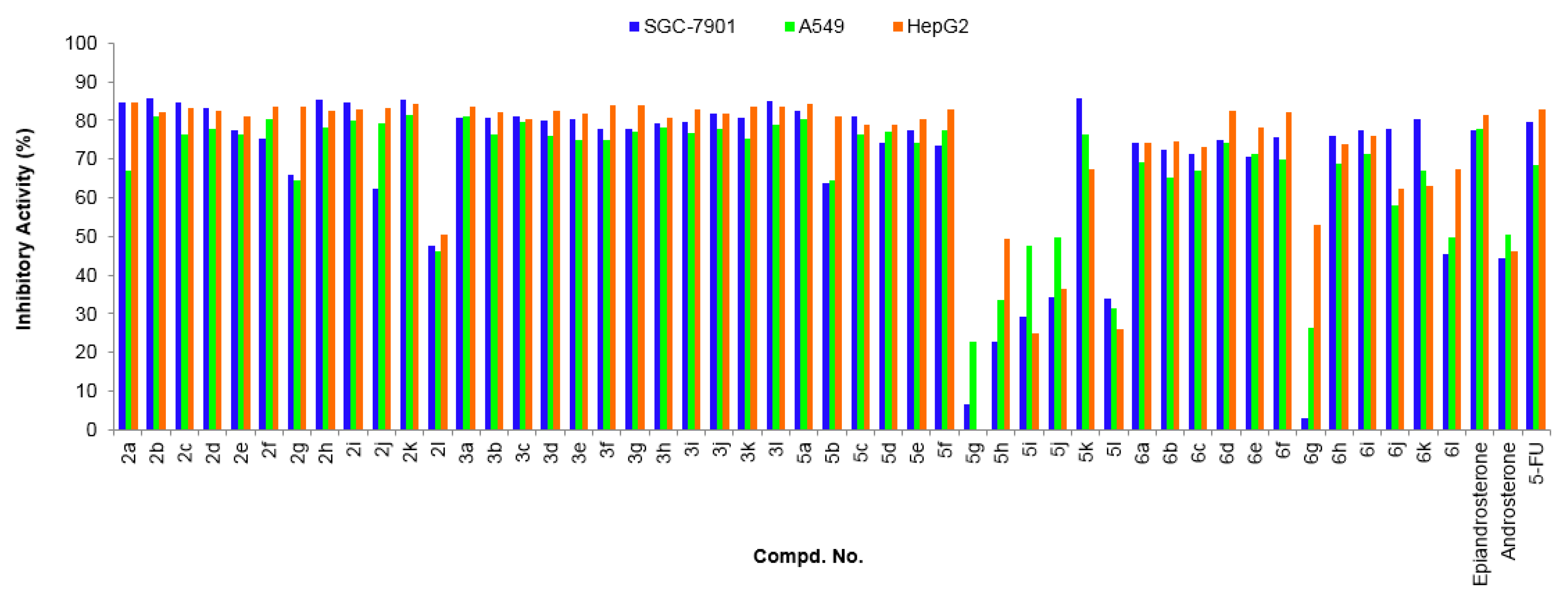

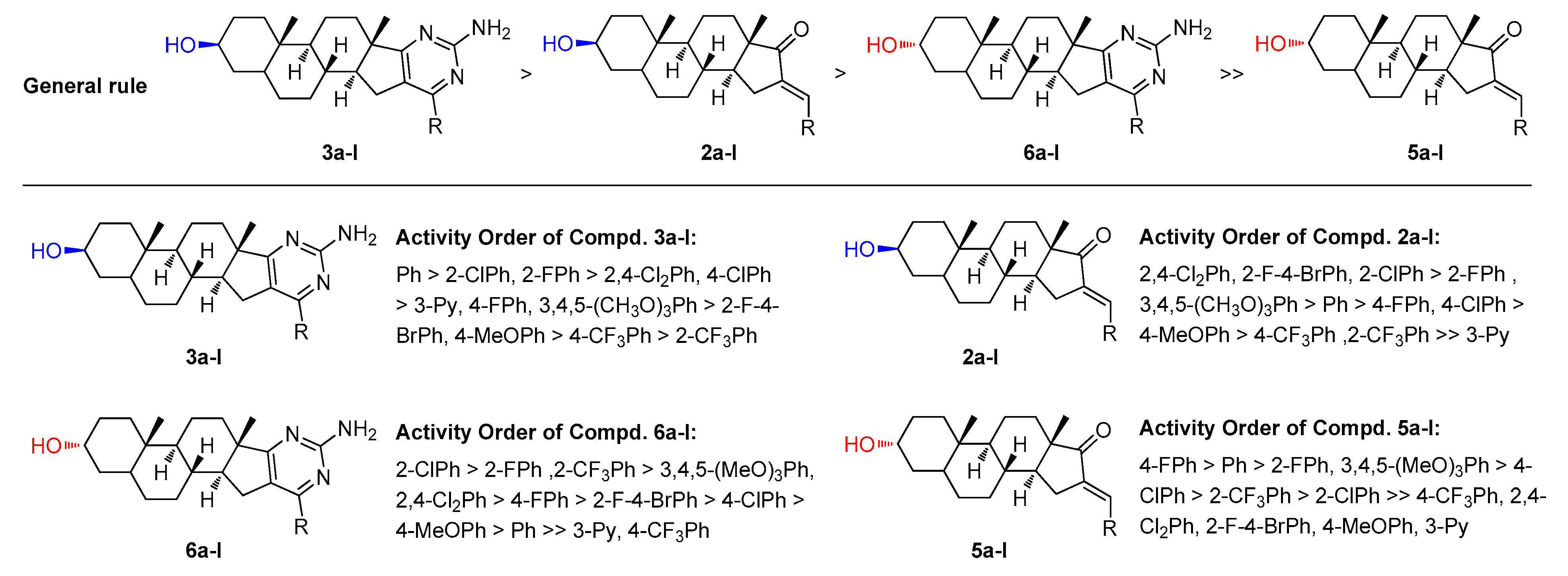



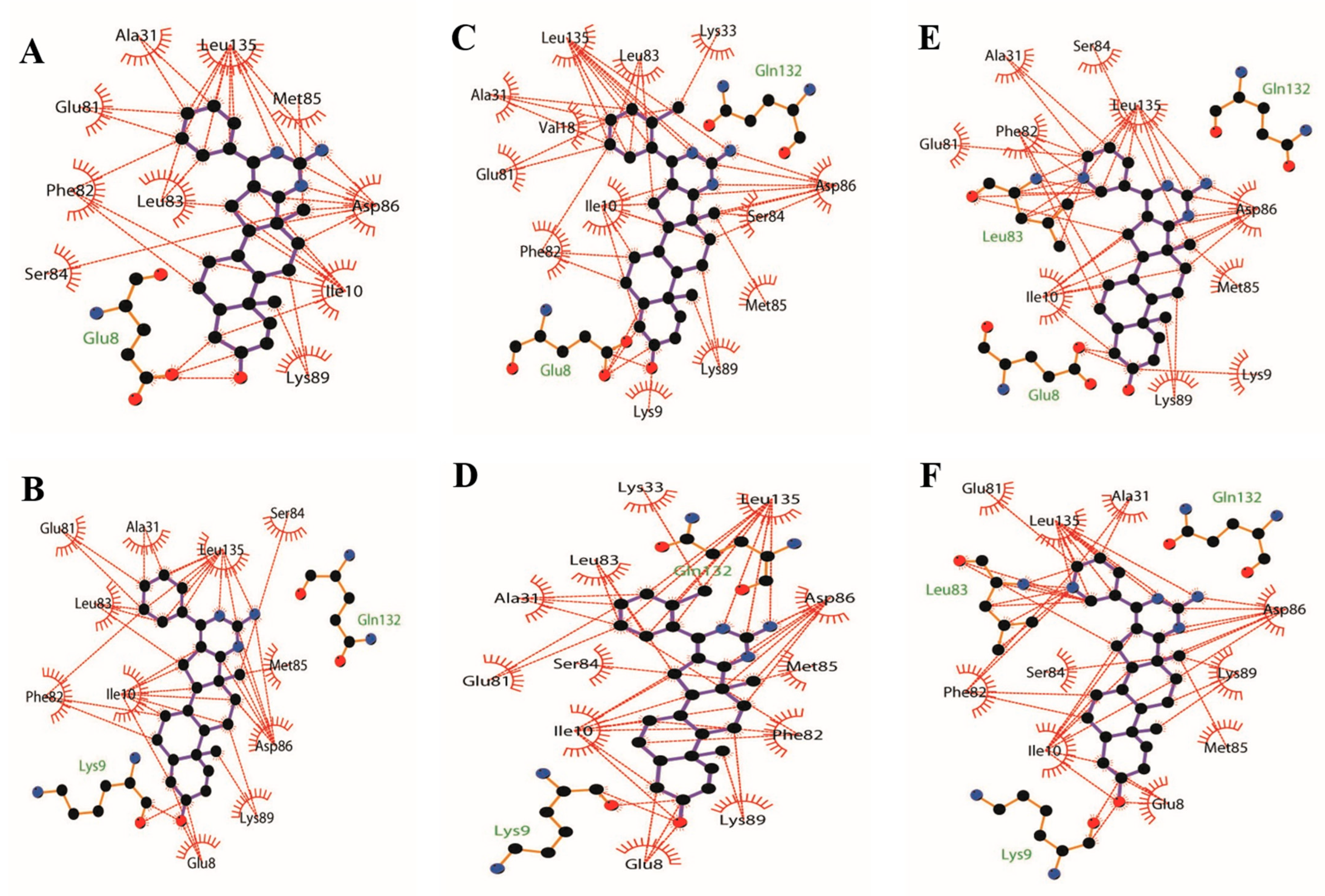
| Entry | Compd. No. | Substrates (R) | In Vitro Cytotoxicity IC50 a (μg/mL) | ||
|---|---|---|---|---|---|
| SGC-7901 b | A549 b | HepG2 b | |||
| 1 | 2a | Ph | 5.13 ± 1.59 | 11.74 ± 1.72 | 4.74 ± 1.46 |
| 2 | 2b | 2-ClPh | 2.19 ± 0.49 | 3.24 ± 0.42 | 1.80 ± 0.08 |
| 3 | 2c | 4-ClPh | 8.80 ± 1.46 | 12.52 ± 2.71 | 8.02 ± 1.38 |
| 4 | 2d | 2-FPh | 3.19 ± 0.38 | 6.81 ± 0.72 | 1.71 ± 0.39 |
| 5 | 2e | 4-FPh | 8.45 ± 1.20 | 8.94 ± 1.58 | 4.46 ± 0.66 |
| 6 | 2f | 2-CF3Ph | 22.03 ± 0.61 | 11.38 ± 2.14 | 8.13 ± 1.43 |
| 7 | 2g | 4-CF3Ph | 21.28 ± 3.07 | 24.93 ± 3.60 | 10.58 ± 0.75 |
| 8 | 2h | 2,4-Cl2Ph | 1.94 ± 0.22 | 2.79 ± 0.49 | 1.31 ± 0.38 |
| 9 | 2i | 2-F-4-BrPh | 2.04 ± 0.09 | 4.08 ± 0.42 | 0.80 ± 0.16 |
| 10 | 2j | 4-CH3OPh | 13.25 ± 0.97 | 10.70 ± 0.78 | 6.63 ± 1.10 |
| 11 | 2k | 3,4,5-(CH3O)3Ph | 3.73 ± 0.39 | 3.17 ± 0.74 | 3.17 ± 0.54 |
| 12 | 2l | 3-Py | >40 | >40 | >40 |
| 13 | 3a | Ph | 1.07 ± 0.22 | 0.61 ± 0.19 | 0.51 ± 0.13 |
| 14 | 3b | 2-ClPh | 1.39 ± 0.20 | 1.37 ± 0.17 | 1.31 ± 0.30 |
| 15 | 3c | 4-ClPh | 2.45 ± 0.49 | 6.22 ± 0.98 | 1.09 ± 0.36 |
| 16 | 3d | 2-FPh | 1.79 ± 0.42 | 0.53 ± 0.15 | 0.56 ± 0.10 |
| 17 | 3e | 4-FPh | 2.75 ± 0.51 | 2.91 ± 0.58 | 1.49 ± 0.38 |
| 18 | 3f | 2-CF3Ph | 4.11 ± 0.73 | 2.91 ± 0.54 | 2.46 ± 0.54 |
| 19 | 3g | 4-CF3Ph | 3.77 ± 0.86 | 2.90 ± 0.41 | 1.85 ± 0.12 |
| 20 | 3h | 2,4-Cl2Ph | 2.20 ± 0.24 | 2.57 ± 0.45 | 2.10 ± 0.44 |
| 21 | 3i | 2-F-4-BrPh | 3.05 ± 0.50 | 2.96 ± 0.70 | 2.16 ± 0.12 |
| 22 | 3j | 4-CH3OPh | 3.26 ± 0.21 | 4.00 ± 0.91 | 1.39 ± 0.09 |
| 23 | 3k | 3,4,5-(CH3O)3Ph | 2.86 ± 0.49 | 2.36 ± 0.45 | 0.43 ± 0.15 |
| 24 | 3l | 3-Py | 2.74 ± 0.67 | 2.83 ± 0.66 | 0.55 ± 0.15 |
| 25 | 5a | Ph | 3.53 ± 0.60 | 2.28 ± 0.25 | 1.21 ± 0.37 |
| 26 | 5b | 2-ClPh | 19.16 ± 3.11 | 12.92 ± 0.90 | 7.59 ± 1.86 |
| 27 | 5c | 4-ClPh | 5.14 ± 1.03 | 5.06 ± 1.06 | 3.44 ± 0.89 |
| 28 | 5d | 2-FPh | 4.21 ± 0.68 | 5.17 ± 1.06 | 2.20 ± 0.53 |
| 29 | 5e | 4-FPh | 2.38 ± 0.57 | 3.72 ± 0.35 | 2.19 ± 0.27 |
| 30 | 5f | 2-CF3Ph | 13.95 ± 2.33 | 10.34 ± 1.80 | 5.50 ± 0.98 |
| 31 | 5g | 4-CF3Ph | >40 | >40 | >40 |
| 32 | 5h | 2,4-Cl2Ph | >40 | >40 | >40 |
| 33 | 5i | 2-F-4-BrPh | >40 | >40 | >40 |
| 34 | 5j | 4-CH3OPh | >40 | >40 | >40 |
| 35 | 5k | 3,4,5-(CH3O)3Ph | 4.26 ± 0.86 | 6.13 ± 0.89 | 6.67 ± 1.08 |
| 36 | 5l | 3-Py | >40 | >40 | >40 |
| 37 | 6a | Ph | 16.33 ± 2.06 | 19.93 ± 1.92 | 14.26 ± 1.82 |
| 38 | 6b | 2-ClPh | 4.01 ± 0.31 | 6.04 ± 0.71 | 3.91 ± 0.69 |
| 39 | 6c | 4-ClPh | 8.67 ± 1.38 | 11.43 ± 2.20 | 6.80 ± 1.06 |
| 40 | 6d | 2-FPh | 4.67 ± 1.09 | 7.85 ± 1.82 | 4.76 ± 1.12 |
| 41 | 6e | 4-FPh | 6.65 ± 1.60 | 13.30 ± 0.45 | 6.13 ± 0.92 |
| 42 | 6f | 2-CF3Ph | 4.94 ± 0.95 | 9.08 ± 1.22 | 6.14 ± 0.84 |
| 43 | 6g | 4-CF3Ph | >40 | >40 | 33.38 ± 2.08 |
| 44 | 6h | 2,4-Cl2Ph | 5.75 ± 0.95 | 8.36 ± 0.50 | 6.78 ± 1.48 |
| 45 | 6i | 2-F-4-BrPh | 7.69 ± 1.74 | 17.57 ± 1.51 | 7.79 ± 1.05 |
| 46 | 6j | 4-CH3OPh | 12.38 ± 1.43 | >40 | 12.79 ± 2.40 |
| 47 | 6k | 3,4,5-(CH3O)3Ph | 5.23 ± 0.94 | 9.86 ± 1.15 | 9.52 ± 2.00 |
| 48 | 6l | 3-Py | >40 | >40 | 18.69 ± 2.43 |
| 49 | Epiandrosterone | - | 20.31 ± 2.59 | 11.53 ± 1.36 | 17.25 ± 2.65 |
| 50 | Androsterone | - | >40 | >40 | >40 |
| 51 | 5-FU c | - | 8.81 ± 1.91 | 7.58 ± 0.67 | 7.79 ± 0.65 |
| Kinase | Inhibition Rate at 10 μM (%) | Kinase | Inhibition Rate at 10 μM (%) | Kinase | Inhibition Rate at 10 μM (%) |
|---|---|---|---|---|---|
| ALK | 17.36 a | EGFR(T790M) | −2.43 a | PDGFRα(D842V) | −33.57 a |
| CDK1/CyclinA2 | 22.51 a | FAK | 10.52 a | PIM1 | −14.26 a |
| CDK2/CyclinE1 | −26.89 a | FGFR1 | 11.82 a | PIM2 | 3.72 b |
| CDK6/CyclinD1 | −4.98 b | MET | −4.06 a | ROS | −12.98 a |
| EGFR | −2.96 a | PDGFRα | −11.73 a | ROS(G2032) | −17.44 a |
Disclaimer/Publisher’s Note: The statements, opinions and data contained in all publications are solely those of the individual author(s) and contributor(s) and not of MDPI and/or the editor(s). MDPI and/or the editor(s) disclaim responsibility for any injury to people or property resulting from any ideas, methods, instructions or products referred to in the content. |
© 2023 by the authors. Licensee MDPI, Basel, Switzerland. This article is an open access article distributed under the terms and conditions of the Creative Commons Attribution (CC BY) license (https://creativecommons.org/licenses/by/4.0/).
Share and Cite
Yang, F.; Liu, F.; Min, Y.; Shi, L.; Liu, M.; Wang, K.; Ke, S.; Gong, Y.; Yang, Z. Novel Steroidal[17,16-d]pyrimidines Derived from Epiandrosterone and Androsterone: Synthesis, Characterization and Configuration-Activity Relationships. Molecules 2023, 28, 2691. https://doi.org/10.3390/molecules28062691
Yang F, Liu F, Min Y, Shi L, Liu M, Wang K, Ke S, Gong Y, Yang Z. Novel Steroidal[17,16-d]pyrimidines Derived from Epiandrosterone and Androsterone: Synthesis, Characterization and Configuration-Activity Relationships. Molecules. 2023; 28(6):2691. https://doi.org/10.3390/molecules28062691
Chicago/Turabian StyleYang, Fei, Fang Liu, Yong Min, Liqiao Shi, Manli Liu, Kaimei Wang, Shaoyong Ke, Yan Gong, and Ziwen Yang. 2023. "Novel Steroidal[17,16-d]pyrimidines Derived from Epiandrosterone and Androsterone: Synthesis, Characterization and Configuration-Activity Relationships" Molecules 28, no. 6: 2691. https://doi.org/10.3390/molecules28062691
APA StyleYang, F., Liu, F., Min, Y., Shi, L., Liu, M., Wang, K., Ke, S., Gong, Y., & Yang, Z. (2023). Novel Steroidal[17,16-d]pyrimidines Derived from Epiandrosterone and Androsterone: Synthesis, Characterization and Configuration-Activity Relationships. Molecules, 28(6), 2691. https://doi.org/10.3390/molecules28062691






